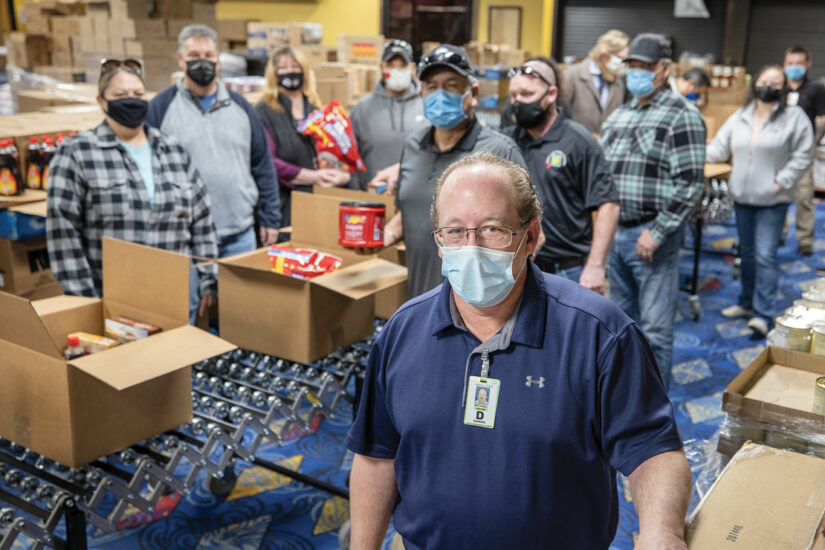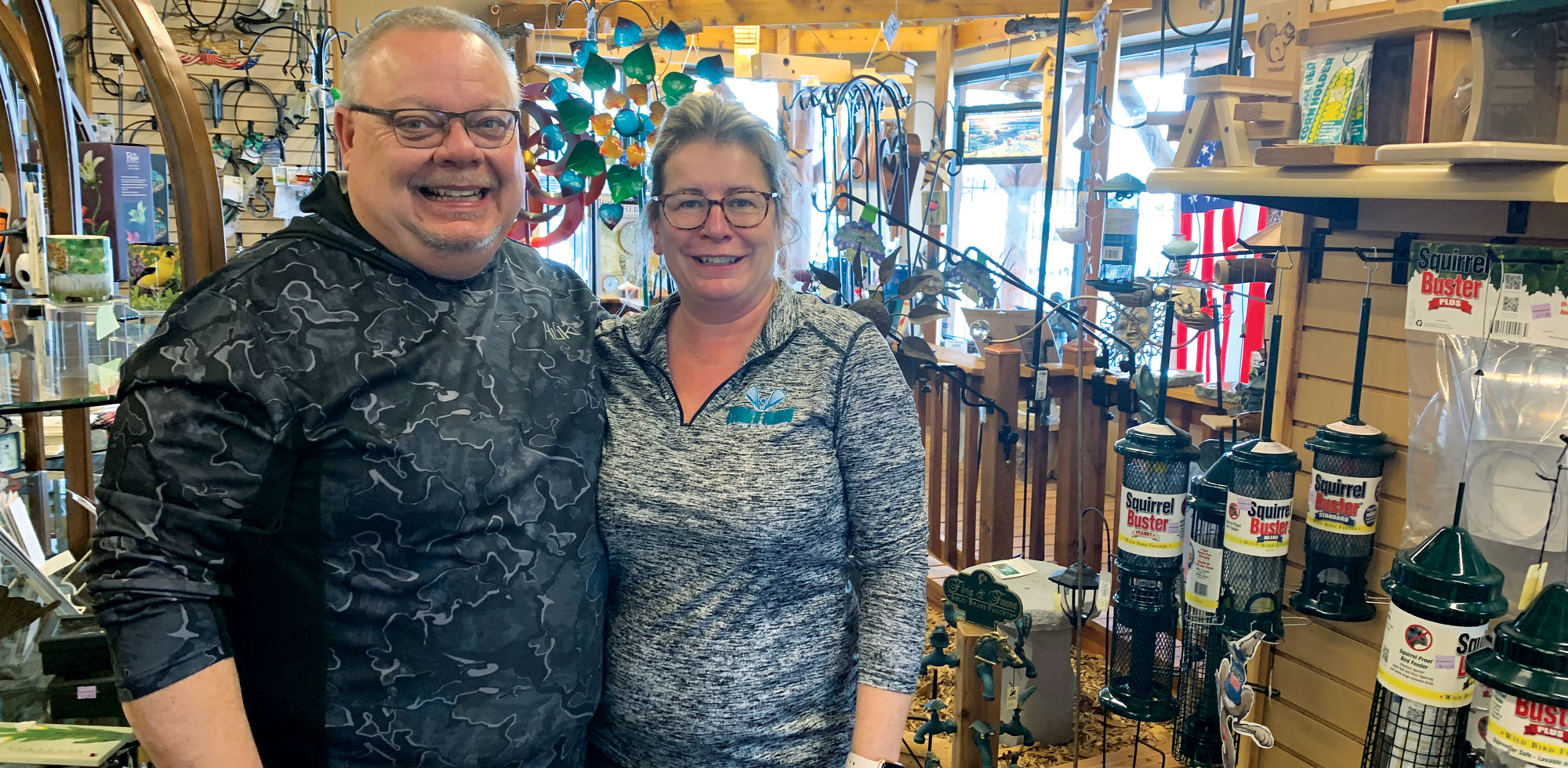
A Year Like No Other
As Central Minnesota recovers from the COVID-19 crisis, the Initiative Foundation doubles down on its mission to strengthen the region it has served since 1986.
By Laura Billings Coleman | Photography by John Linn
Surrounded by thousands of surface miles of lakes, boreal forests and natural beauty, the community of the Leech Lake Band of Ojibwe (LLBO) also lies in the middle of a food desert, with few options for door-step deliveries or quick trips to the grocery store.
“With the lay of the land up here, and no major metropolitan areas around, most folks have to drive upwards of 50 miles just to get the basics,” said Mike Auger, LLBO’s director of gaming operations. “As the COVID-19 pandemic started up, we decided we needed to tackle the problem of food insecurity in our community, because it was also one of the ways we thought we could keep our elders safe at home.”
In March, the Leech Lake Band Emergency Management Team launched the COVID-19 Food Initiative, distributing 700 boxes of pantry staples around the region. “The only qualification for getting the food box was needing it,” said Auger, who oversaw the distribution operation. “We didn’t care if you were a band member, or if you were white, or what your income was. We just got the food out where we thought people could use it.”
As the statewide shutdown continued, and organizers learned more about the community’s needs, LLBO’s COVID-19 Food Initiative grew more ambitious, activating nearly 100 volunteers and working with a nutritionist to ensure that every box contained a healthy range of shelf-stable foods and personal products to nourish families at home. Working with CARES Act funding from the state of Minnesota, supply chain support from Teal’s Market, the local grocery store, and grant funding from the Initiative Foundation and other partners, LLBO has continued its commitment for a full year, delivering nearly 16,000 boxes of food around the region since the start of the pandemic.
“Our goals at the start were just getting through the immediate future,” said Auger. “Like everyone last March, we never anticipated that we’d still be doing this the following March.” He credits collaborations with Second Harvest Heartland, the state of Minnesota and a host of other partners for helping the band “cut through red tape and make a huge difference to people during a tough time. Food security was an issue before the pandemic, but now that the problem’s been brought to the surface, I think we’ve seen there are solutions that can help solve it. I hope that’s the lesson we’ll take from this after the pandemic ends.”

ESSENTIAL NEEDS
The Leech Lake Band of Ojibwe’s COVID-19 Food Initiative is one of more than 1,400 nonprofits and businesses the Initiative Foundation helped to fund in 2020, the biggest and the busiest year in the organization’s 35-year history. “We were founded in the wake of the farm crisis, so we pride ourselves on being prepared for challenges, but it would be an understatement to say this is not the year we had planned,” said Don Hickman, Initiative Foundation vice president of community and workforce development. While the Foundation stepped up its grantmaking, nearly quintupling the dollars it awards in a typical year, the needs across the region were even greater.
“We have a long history of funding capacity building and strategic planning and things that will set communities up for long-term success, but this year, for the first time, we decided we had to directly fund the service of essential needs,” said Hickman. “With grant requests outstripping available resources by more than a 10:1 ratio, we had to make some tough choices and focus on the needs that were most acute.”
For instance, as communities with meat processing plants emerged as COVID-19 hot zones, the Initiative Foundation reached out to underserved communities in Cold Spring, Long Prairie and Melrose by hiring two bilingual disaster response specialists to ensure that employees, often from Latino and Somali communities, had the information they needed to stay safe in the workplace and to access other essential services during the pandemic. The effort resulted in the delivery of nearly $1.2 million in support to the designated communities.
With hundreds of small businesses forced to close during the shutdown or to find new ways of meeting customers, the Foundation also administered $7.66 million in small business relief grants in partnership with the Minnesota Department of Employment and Economic Development (DEED), which helped to provide $10,000 grants to 766 small businesses in the region. The effort, funded by federal CARES Act dollars, also included a special allocation of $110,000 for a St. Cloud cultural mall and its tenants.
With a serious child care shortage already in place, and essential service workers pressed for solutions, the Initiative Foundation also helped to fund a new accelerated early childhood certification program at Pine Technical & Community College, one of several “one year to a new career” programs that have surfaced to help reactivate workers laid off during the shutdown. These programs also solve labor shortages that were a problem before the pandemic.
All totaled, the Initiative Foundation infused more than $14.2million in relief efforts throughout Central Minnesota.
“It’s remarkable that the economy is doing as well as it is in spite of a global pandemic, and for that I think we can thank lots of diligent entrepreneurs, and the fact that governments and the philanthropic community are stepping up. It’s taken everyone working together to take on this challenge,” said Initiative Foundation President Matt Varilek.

FUTURE SOLUTIONS
The last year of shut-downs, school closures and supply chain challenges have also revealed trouble spots in Central Minnesota’s economy. “Even though the economy is strong in aggregate, it also reflects some pretty vast disparities,” Varilek said, noting that while hospitality and personal service businesses have been devastated by the pandemic, other sectors like construction, outdoor recreation and some manufacturing have seen big gains. “Some businesses in the region have had their best year ever, while others are in danger of going away for good.”
Jeff Wig, the Initiative Foundation’s vice president for entrepreneurship, agrees. “When the shutdown started there was a shock and awe phase last spring and summer that has given way to an adjustment phase as people found new ways of doing business.” For instance, favorite local restaurants revved up websites and offered deliveries and curbside pick-ups, while other operations make quick pivots, like Brainerd’s The Teehive, a custom T-shirt hop that quickly began producing face masks and other personal protective garments. While the Paycheck Protection Program and other small business loan programs have offered a lifeline to many small businesses in the region, “giving people additional loans for emergency use is not always what they want,” Wig said. “There are many other businesses that have decided it’s not worth it to stay open and lose money, but they’re looking for a way to grow forward as we start to emerge from the COVID-19 tunnel.”
Child care surfaced as another major challenge, as homes or centers closed or reduced class sizes and parents took on teaching duties at home. “Problems with finding or hanging onto child care is the single biggest factor affecting an employee’s productivity and the single biggest reason for absenteeism. The pandemic made that painfully clear,” said Marnie Werner, vice president for research and operations at the Center for Rural Policy and Development. “If you were having problems with child care, particularly in rural communities, you might be able to fall back on grandma or an aunt in a pinch, but with COVID, you can’t rely on your older relatives, which cut off that avenue for patching the problem.”
In a tight job market, employers could replace a child-care challenged employee with a new hire. But there are more unfilled jobs than skilled workers in the region, a trend that’s continued through the pandemic. “Businesses are starting to realize and understand that they do have to get involved in solving this problem,” said Werner. “And for policy makers and the public in general, I think this year has really clarified how much child care is part of the infrastructure that supports economic growth.”
With widespread vaccine distribution now within view, Varilek says a strong recovery for the region will also depend on following the public health lessons we’ve learned over the last year. “The health of Central Minnesota’s economy and the coronavirus are closely connected,” he said. “Fortunately, this virus is beatable and we’ve learned how to operate our economy more openly than we did in the early days. But getting to the next stage of the new normal is going to depend on as many of us as possible getting vaccinated just as soon as we can.
“We shouldn’t get ahead of ourselves in terms of our expectations about immediately getting together in large groups, traveling for work and leisure and other things we’ve missed during the pandemic, but the fact we’ve been able to maintain the economic strength we’ve seen during this year gives me great optimism,” he said. “If we’re doing as well as we are with all of these pandemic constraints in place, just imagine where we can be in the future.”
COVID-19 IMPACT UPDATE
Since the onset of the pandemic…
- 1,400+ BUSINESSES & NONPROFITS financially supported
- $4.1M LOANS, LENDING ACCOMMODATIONS
$1.2 million in new loans
$2.85 million in adjusted loan terms - $10M GRANTS
$7.76 million in small business and cultural mall relief grants
$410,000 to child care, early childhood
$378,000 to nonprofits
$238,000 via Partner Fund relief
$1.05 million in CARES Act funding distributed on behalf of Pine County - $14.2M TOTAL IMPACT
A special thanks to the Minnesota Department of Employment and Economic Development (DEED) for its grant and lending partnership and to the many anonymous donors and Minnesota-based foundations for aligning with the Initiative Foundation to drive crucial support into the region, including the Blandin and Bush foundations and the Minnesota Council on Foundations and its Minnesota Disaster Recovery Fund on Coronavirus. Support also comes from the Center for Disaster Philanthropy; Compeer Financial; the Minnesota Department of Education; Otto Bremer Trust; and Wells Fargo.
THE HOME OFFICE
Could a year of working from home finally change the way we work?
Since the dawn of broadband, demographers have predicted that remote work could be a game-changer for rural communities, attracting newcomers with fast internet, low cost of living and high quality of life. But until the pandemic hit last spring, the theory had never been put to the test.
“With so many of us now working from home during this crisis, it’s taken the debate about remote work much farther down the road than we’ve ever been before,” said Patti Gartland, president of the Greater St. Cloud Development Corporation. “A lot of folks who might have been reluctant to put remote work into play before the pandemic now have gotten past a lot of fears and unsubstantiated concerns.”
In fact, a recent nationwide survey from the accounting giant PwC (formerly PricewaterhouseCoopers) found that 83 percent of employers believe remote work during the pandemic has been a success, while 55 percent of employees hope to be able to work remotely at least three days a week even after the pandemic subsides. Whether you like the flexibility or are frustrated by frayed connections with colleagues, the future of where and how we work may depend on some of the discoveries that employers and employees made over the last year.
Work and home don’t have to be neighbors: Once a strong indicator of quality of life, living close to your job is becoming less and less relevant in some business sectors. “In traditional economic development, the job comes first, and the decision of where to live comes second,” said Ben Winchester, a rural sociologist with the University of Minnesota’s Extension Center for Community Vitality. “But now we’re at a point in history where your choice of residence has been decoupled from our economic decisions.”
The flexibility to live where you like and log in for work could be a boon to businesses in Central Minnesota, particularly those facing workforce shortages. “For many businesses, remote work could substantially broaden your labor pool. You don’t have to worry about where your employees live or how far they have to commute,” said Gartland. “But the double-edged sword is that it means people in our region aren’t captive to employers in our region.”
Rethinking business travel: While air travel is expected to pick up as the pandemic winds down, business trips may be grounded for the foreseeable future. “What we’re hearing from our manufacturers and marketers that relied on extensive travel and trade show interaction is that there’s been a significant change in those industries to the point where they’ve learned new, more efficient ways of sharing information about their product or service with their end customers,” said Gartland, who also serves on the Metropolitan Airports Commission. “We won’t be reverting back to the old ways, and we’re coming to recognize that business travel may never make a full return to what it was.” Instead, she sees gains ahead for businesses that handle advertising, marketing, video production and website development “as we put more emphasis on electronic tools to share information about our region, rather than face-to-face interactions.”
Speed matters: While 83 percent of rural Minnesota now has download speeds of 25 megabits per second (Mbps) and upload speeds of 3 Mbps—roughly the speed it takes to stream a TV show—157,000 rural households don’t meet that threshold. While Minnesota is aiming to bring much faster service (100Mbps download/20Mbps upload) to every corner of the state by 2026, “the pandemic has made the gaps that exist much more apparent, when employers who’d like to have people working from home found employees who just didn’t have adequate broadband,” said Gartland. After a year when client meetings, school days, doctors appointments and most of our entertainment options moved online, “improving broadband in outstate areas has become a critical piece of the equation.”
Mentoring matters: While many seasoned employees working from home for the first time discovered silver linings like giving up the commute to gaining productivity and family time, many younger workers struggled. “The pandemic has had a huge impact on young people who have lost their networks, or their connections to work colleagues, and who wonder how they’re ever going to catch up,” said Don Hickman, the Initiative Foundation’s vice president for community and workforce development. In fact, PwC’s U.S. Remote Work Survey found that workers with less than five years of job experience felt less productive at home than their older cohorts, and were far more interested in making a return to the office. “That tells us that no matter how technically sophisticated the next generation may be, they still need and want to be mentored at work and to feel part of a workplace culture,” Hickman said.
Resident recruitment: Studying real estate has been a hot topic and a trending leisure activity during the pandemic, as major corporations have begun dropping downtown leases, and internet property views of rural real estate offerings have gone up by more than a third. To take advantage of this possible turning point, Winchester says small towns and rural communities must roll out the welcome mat to potential residents just as they do for tourists. “The pandemic and low interest rates have piqued interest in people who might not have considered a small town before. But it’s not enough to show someone the job they could have in your community, you have to show off what their life is going to be like,” he said. “In a lot of ways, the pandemic has reinvigorated the local economy, and people don’t want to live in an economy—they want to live in a community.”